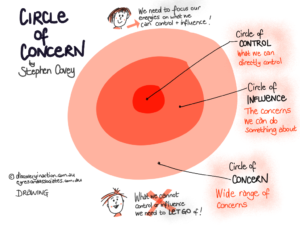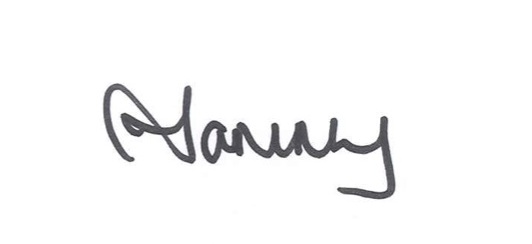
It’s been a year when pretty much everything has felt completely out of control. In fact, that is probably one of the big lessons we have all learnt, is how little we actually do control.
But that doesn’t stop us worrying about all manner of things. From the day to day minutiae of life (how will I get this child here at this time and also be across town at the same time?); through to more substantive matters like how will we pay the mortgage if my husband’s job is under threat. Through to: the world is falling apart.. I’ m worried about climate change, geopolitical tensions, the pandemic etc etc etc..
It can be completely overwhelming. It can feel like things are completely out of control and may never again be back in control.
Circles of Influence and Control
So, it is a great reminder from @NOBL around our circles of influence or concern. This Stephen Covey’s theory has been around for a long time; and it is has stood the test of time.
It starts by being clear about what you’re worrying about. Sometimes, even the act of writing it all down (and I mean everything), is enough to start to bring some clarity and lightness of load. There’s something about seeing all your innermost concerns and worries written on paper that starts to rob some of the power from them.
Then categorise them according to what you can control, what you can influence and what you’re concerned from afar at.
Zone of Control
NOBL has this to say:
Your personal zone of control is what you directly impact: the work you engage in, where you spend your time and energy, the things you choose to focus on. Start by making an inventory of those things you can control, everything from how you start the day and the meetings you accept, to your posture. (New leaders in particular tend to embark on a power grab to add to their zone of control, but ironically, this often erodes their zone of influence as they exhaust political capital.) Then adopt the gambler’s mindset: once a decision is made and the outcome is out of your hands, accept or even enjoy the process, and view it as an opportunity to learn and improve.
Zone of Influence
Zone of Influence is described as:
Your zone of influence is what (or whom) you can affect indirectly: it’s the conversations you have with colleagues, it’s the enthusiasm and support you demonstrate for a given initiative. You can’t directly control the result, but your behavior can help sway others to take action. This is the realm of soft power, so hone your negotiation and persuasion abilities—it’s what separates great talent from great leaders. In fact, the best leaders we’ve worked with often pour most of their effort into expanding this zone through network building and compromise.
Zone of Concern
And then there’s your zone of concern. This is, of course, the largest zone. When considering this domain, you may feel like either throwing up your hands in despair, or worrying and burning yourself out in an attempt to change something beyond your control. The “easy” advice often given here is to ignore everything in this circle and keep your head down. Good luck with that. The honest answer is that this will always occupy some of your attention, but you can learn to more actively manage how much space these concerns consume. Ask yourself if the level of rumination on these topics is healthy (is it causing you to ignore other duties or even people in your life), or if it’s causing lasting harm to your mental well-being.
Where to from here?
Once you have named your concerns and categorised them, you’ll start to see a plan of action emerge. Or at least you’ll see where your energy can be most productively spent. And if you’re spending more time in the two outer zones, you can have some hard chats with yourself about how useful that is both from a productivity perspective, and from an ongoing emotional and mental health perspective.
It’s at this point that getting assistance – whether from a trusted family member or friend, or from a professional like a coach or psychologist, can help.
THE TAKEAWAY
Like all good models that have stood the test of time, this one works if you let it.
Go through the steps.
- Get it all out
- Categorise
- Work out a plan
- Get help if needed
They don’t need to be longwinded or dramatic. Just get a notebook or a blank screen and start getting it all out and down.
WANT SOME MORE RESOURCES?
- Start Where You Are – NOBL Post
- The Circle of Influence – Youtube Video
- Circle of Influence- Discovery in Action
WANT MORE?
If the above has whetted your appetite, and you’re keen for more.. Here are some ideas:
Does leadership interest you? You can sign up to my FREE seven day “Be a Better Boss Challenge” by clicking here. And you can click here to buy my book.
Want to chat? Click here to get in touch.
Want some help in meeting your goals? Sign up to the permission to dream programme, by clicking here.
Want more to read? You can read any of the 300+ blog posts on this site, by clicking here.
See you soon,


